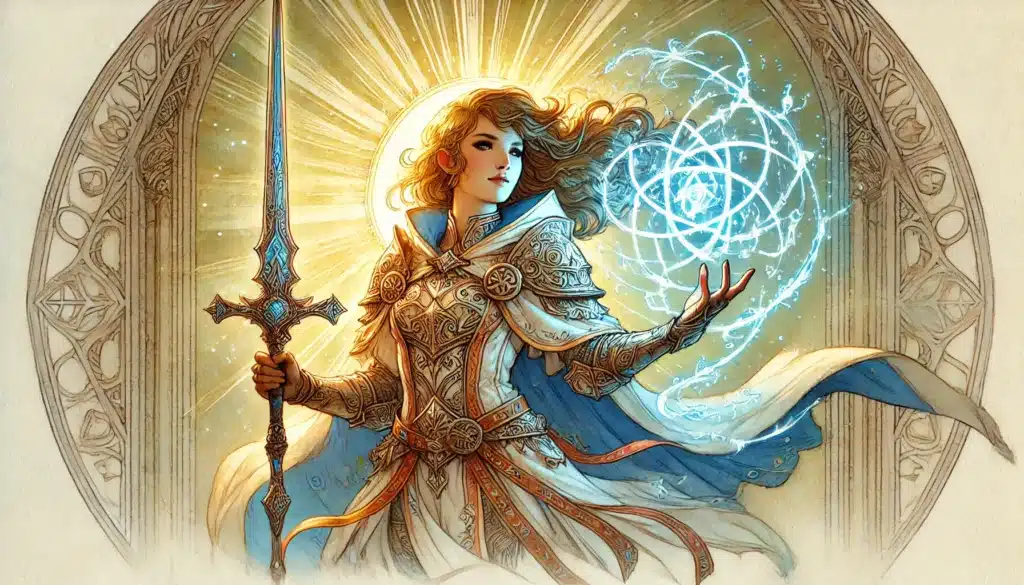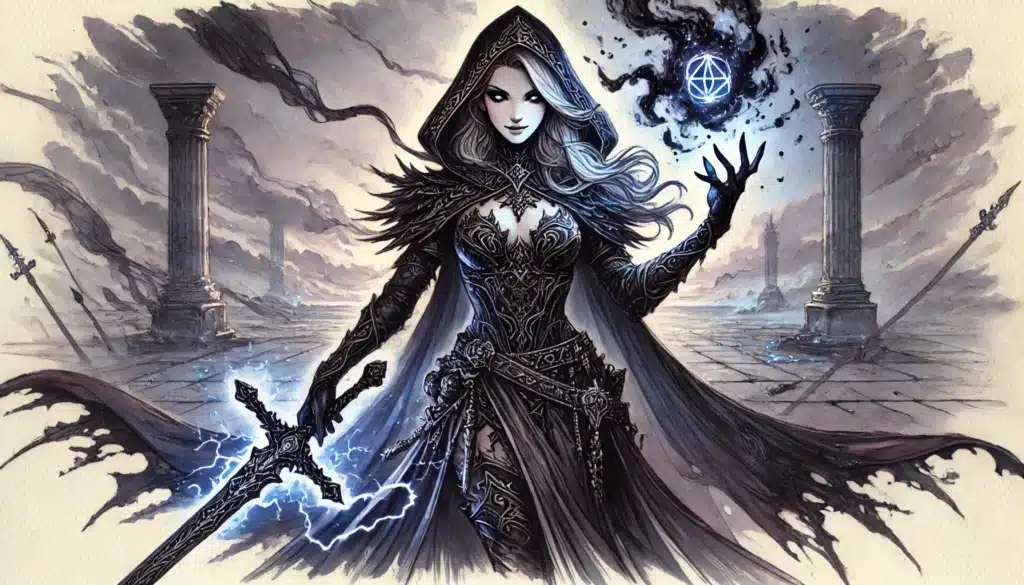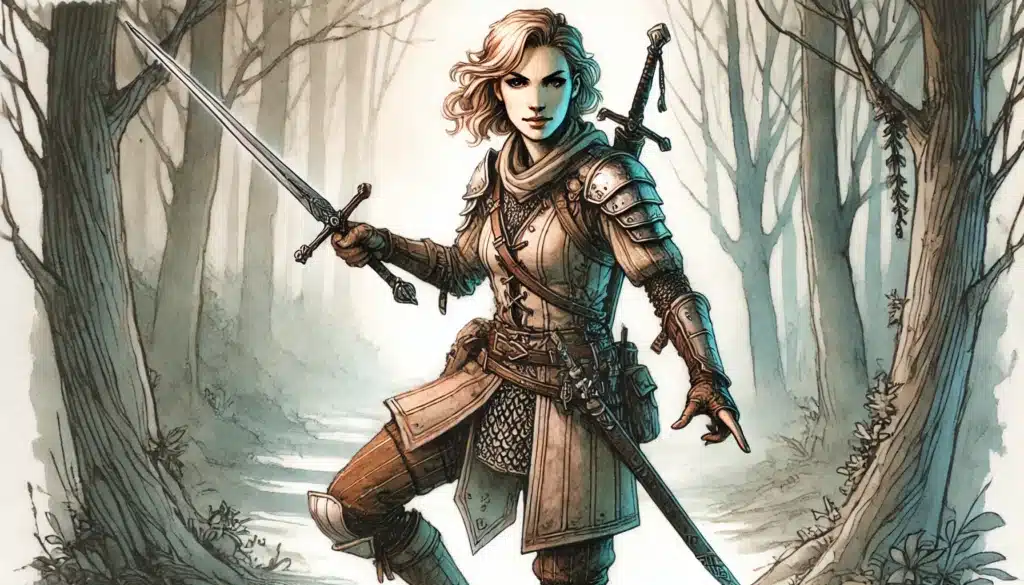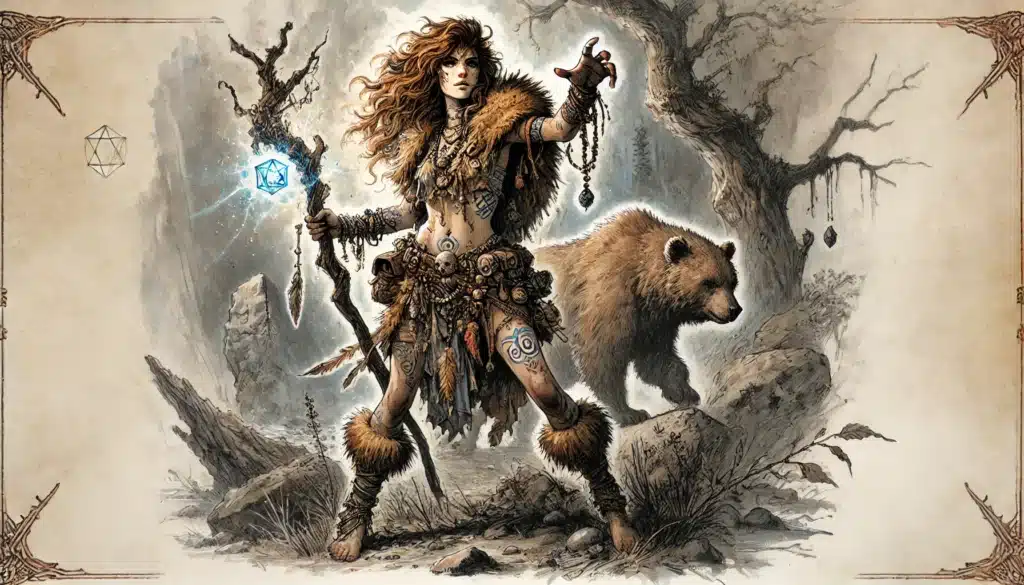Multiclassing in Dungeons & Dragons 5th Edition is equal parts art and science, a bit of tantalizing alchemy where ambition meets spreadsheets, and where every level split whispers of forbidden power. For veterans itching to break free from the shackles of single-class monotony, multiclassing offers that fresh, crackling spark. Suddenly, your fighter knows magic that bends fate, or your sorcerer wears armor meant for celestial knights. The allure is undeniable: clever multiclass builds let you defy expectations and dance along the razor’s edge of the game’s mechanics.
The mechanical advantages are profound. Combining classes can let you devastate enemies with explosive burst damage, stack spellcasting for arcane depth, or shrug off wounds that would fell lesser adventurers. Dipping into a second (or even a third) class can unlock action economy tricks, powerful synergies, and a kit that feels uniquely yours. Yet, the path to power is riddled with trade-offs: delayed capstone abilities, awkward ability score spreads, and the ever-present danger of being a master of none rather than all.
But let’s be clear: this isn’t about being “that player” who ruins games with cheese. Optimization doesn’t mean stealing the spotlight or minimizing the fun of others; instead, it’s about expressing your creativity through the framework of the game, making every turn matter, and elevating the tactical drama of your sessions. Table balance and group enjoyment should remain your north star.
This guide is for players who want to squeeze every drop of efficiency and excitement from their character sheets—without crossing over into disruptive min-maxing. Here, you’ll find five multiclass combos that reward system mastery, strategic play, and, most importantly, a sense of joy in clever character design.
Each multiclass below comes with a memorable nickname and a step-by-step build guide. Ready to blend raw power, tactical nuance, and a touch of creative chaos into your next character? Let’s leap into 5e’s most infamous combos—and show you exactly how to build and play them. (And if you need a free fantasy name generator, we’ve got you covered!)
Sorcerer / Paladin: The Smite Battery
Few multiclass builds are whispered about with such begrudging awe as the Sorcerer/Paladin—sometimes called the “Sorcadin” or, more dramatically, “the one-turn boss killer.” With this combo, your party’s holy champion doesn’t just deliver justice—they unmake reality itself, dousing enemies in a storm of radiant energy and magical fury, all while barely breaking a sweat.
Try my AI Tabletop RPG generators...and an extensive library of content!
It begins with Divine Smite, the Paladin’s most iconic feature, which lets you burn spell slots for extra radiant damage on a melee hit. Now, imagine supplementing your limited Paladin slots with the Sorcerer’s spell slot progression—suddenly, every swing could unleash devastating nova damage, especially when you strike with a well-timed critical hit. The synergy is made even sweeter because both classes use CHA as their primary stat, allowing you to pour every ounce of power into a single ability and become a force of nature.
And then there’s Metamagic—Quickened Spell is a favorite here. Want to paralyze a boss with Hold Person and then smite them into oblivion with two attacks in the same turn, all but assuring critical hits? With Sorcerer’s flexible spellcasting, it becomes a chillingly real possibility. Paladin’s auras and defensive magic (like Shield and Haste) further cement your status as a nigh-unkillable juggernaut, blending offense and defense into one glorious package.
But it isn’t just about the big hits. You’ll find toolkit breadth, too—healing magic, support spells, crowd control. You stride into battle as an armored arcane artillery piece: the frontline face who bolsters allies, devastates threats, and can laugh off a fireball or two. This power isn’t free, of course—it requires careful planning, setup, and the courage to strike at the exact right moment.
In the hands of a tactician, Sorcerer/Paladin isn’t just about numbers. It’s about creating those legendary, campaign-defining moments where the table sits agape as you topple the untoppleable—and then stride away, cloak billowing, ready for the next challenge.
⚔️ Fantasy RPG Random Tables Books
Make life as a Gamemaster easier…
If you play Dungeons & Dragons, Pathfinder, or other fantasy RPGs, this
RPG random tables series
is packed with encounters, NPCs, treasure, and more. Available in eBook or print—either way, you’ll have a wealth of adventure ideas at your fingertips.

How to Build “The Nova Knight” Multiclass Build
Welcome to the realm of raw, devastating power, where your enemies tremble at the mere mention of your name—the Nova Knight. In this hero’s journey, you’re not just another tank or damage dealer; you’re the embodiment of righteous fury, a celestial storm that descends upon your foes with a radiant vengeance. Whether you’re slicing through baddies or unleashing the full might of your spell-laden strikes, your presence on the battlefield will leave allies cheering and enemies cringing. So gear up, tighten that armor, and prepare to redefine what it means to deal “boss-level” devastation. Building the Nova Knight is all about maximizing efficiency and impact with every action you take. It’s not just about throwing a number of attacks; it’s about strategically queuing up the right combination of smites and spells to ensure each turn stacks the odds in your favor. As you weave through the complexities of your spells and melee attacks, remember: timing is key. Knowing when to unleash a single savage blow backed by your towering arcane forces or when to grant your allies that much-needed edge can turn the tide of any encounter. Now, let’s dive deep into the mechanics of this glorious build and craft a character that is not only powerful but an absolute joy to play.
Step-by-step Guide for Nova Knight D&D Multiclass Build:
- Start as Paladin for heavy armor proficiency and WIS/CHA saves.
- Take Paladin to level 2 for Divine Smite and a fighting style (Defense or Dueling recommended).
- Continue Paladin to level 6 for the aura (Aura of Protection is a game-changer).
- Choose Oath of Vengeance (for bonus mobility and advantage) or Oath of Conquest (for crowd control and presence).
- After Paladin 6, begin Sorcerer progression—for most campaigns, aim for Sorcerer 14/Paladin 6 or Sorcerer 18/Paladin 2 at high level.
- Pick Divine Soul (healing, access to cleric spells) or Shadow Sorcerer (durability, control).
- Feats: Prioritize War Caster (concentration and reaction spells in melee) and Resilient (CON) for save bumps.
- Ability scores: CHA (max ASAP) > CON > STR (if you plan to melee in heavy armor) or DEX (for medium/light builds).
- Key spells: Shield, Hold Person (paralyze for crits), Haste (self-buff), Bless.
- Metamagic: Quickened Spell (cast a spell and attack in same turn), Twinned Spell (for Hold Person/Monster).
- Smite usage: Save Sorcerer slots for crits, especially with Divine Smite—paralyze first, then nova.
- Typical combo: Quickened Spell Hold Person on an enemy, attack for automatic crits, dump highest spell slot into Divine Smite.
- Between boss fights: Use aura and healing to support party.
- Defensive rotation: Shield + resistance buffs, Aura of Protection for group saves.
- Prepare for nova: Don’t blow resources on mooks, save setup for the right fight.
- Adjust spell preparation per day’s challenge—bring utility or support as needed.
Burst builds like the Nova Knight live for those all-or-nothing moments. You’ll shine brightest when you stack everything into a single, devastating turn: paralyze the villain, crit smite twice, and laugh as the DM sighs in defeat. These turns are legendary—but the true art is knowing when to hold back, when to strike, and how to keep your resources ready for the final act.
Remember: the biggest risk isn’t running out of damage, but running out of flexibility. Don’t become dependent on always nova-ing; you’re also the party’s heavy armor, aura, and face. Some days, the most powerful thing you can do is protect the ones behind you, and save that thunder for when the whole table needs a hero.
Hexblade Warlock / Sorcerer: The Arcane Blade
Blurring the line between warlord and spellweaver, the Hexblade/Sorcerer multiclass is charisma-fueled versatility incarnate. It’s a build that wields both blade and spell with equal confidence—one hand ready to eldritch blast foes into the abyss, the other gripping a shadow-forged weapon that whispers doom. You’re a duelist, a blaster, and the silver-tongued avatar of the arcane.
Hexblade unlocks melee proficiency, medium armor, shields, and the party-saving boon of turning your CHA into your attack stat—no more spreading yourself thin across multiple abilities. Alongside Pact of the Blade and Agonizing Blast invocation, you can switch from bow to blade at a whim, pumping out reliable damage at any range.
What truly earns this build legendary status, though, is its action economy. Metamagic from Sorcerer (especially Quickened and Twinned Spell) lets you cast, blast, and attack with staggering efficiency. You can twin critical debuffs, quicken a Hold Person for that “glass cannon moment,” or subtly shape the very flow of combat without ever showing your hand.
Hexblade’s Curse cranks spike damage even further, while Eldritch Smite—powered by short-rest Warlock slots—offers brutal burst options. Did we mention Warlock spell slots refresh on a short rest, and can fuel Sorcerer spells, too?
And when the swords are sheathed, you’re unmatched in charisma-driven skills: intimidating, deceiving, persuading, leading. Whether you need to be the party’s face, its arcane muscle, or the tactical backbone, Hexblade/Sorcerer says, “Why not all three?”

How to Build “The Charmer” Multiclass Build
Welcome to “The Charmer,” where you’ll don the mantle of the ultimate social and combat dynamo! Picture this: a character who can waltz through the court of nobles with the charisma of a rock star, then flip the script in combat, laying waste to foes with a deadly mix of magic and melee. You’re not just any adventurer; you’re the vibrant heartbeat of the party, effortlessly charming your way into allies’ hearts while casting doubt and fear into your enemies. With a wink and a flourish, you’re ready to turn the tide of any encounter—be it through a well-placed eldritch blast or a disarming smile that leaves foes vulnerable to your wicked attacks. Building “The Charmer” is all about embracing your dual nature as both a charismatic leader and a ruthless combatant. With the Hexblade’s ability to make CHA your attack stat and the Sorcerer’s spellcasting versatility, you’ll wield your magic and sword with lethal precision. Layer in tactical metamagic and the cunning from your rogue-ish side, and you’ll create a whirlwind of chaos on the battlefield. You can manipulate the flow of combat and social settings with equal ease, blending smooth talk and sharp blades into a deadly dance. So get ready to step into the spotlight and showcase the strengths of a character whose charm is matched only by their prowess in battle!
Step-by-step Guide for The Charmer D&D Multiclass Build:
- Start Sorcerer for Constitution saving throw proficiency.
- Take 1 level in Sorcerer for spellcasting and Metamagic options as soon as possible.
- Move into Warlock for 2-3 levels for Hexblade features and invocations.
- Choose Hexblade Warlock archetype for CHA-to-attack rolls (melee and ranged).
- Take Pact of the Blade at Warlock 3 for weapon versatility, if desired; otherwise, extra invocations.
- Best invocations: Agonizing Blast (add CHA to Eldritch Blast), Devil’s Sight (synergy with Darkness), Improved Pact Weapon.
- Sorcerer subclass: Shadow (for survivability and Darkness synergy), Divine Soul (healing and flexibility), or Clockwork (control).
- Metamagic: Twinned Spell (double-target debuffs), Quickened Spell (bonus action casting), Subtle Spell for social encounters.
- Stat priority: CHA > CON > DEX.
- Key spells: Eldritch Blast, Armor of Agathys (Warlock), Shield, Counterspell (Sorcerer), Darkness (for Devil’s Sight cheese).
- Split: generally Warlock 2-3 / Sorcerer 17-18; Hexblade 2 gives essentials, more is optional for specific invocations.
- Choose weapon focus to suit style—rapier, longbow, or all-in on spell blasting.
- Use Warlock slots for upcasting Sorcerer spells when needed.
- Consider Resilient (CON) or War Caster as feats for concentration.
- Optimize for short-rest resource management—plan when to refuel.
- Leverage CHA for skillmonkeying and party face duties.
- Prepare for combo turns: Darkness + Devil’s Sight for safe melee, Hold Person + Twinned for control.
With this build, you’ll wreck shop in both combat and conversation. You’re the ultimate party face, able to glide through intrigue, negotiations, and barroom brawls with a mirthful grin and a silver tongue. In battle, no one escapes the reach of your blade or the sting of your magic.
Play to your strengths—fill gaps in the party with crowd control, chest-thumping leadership, or raw magical firepower. This combo thrives on adaptability and the pure fun of being good at everything. Just remember: versatility is your secret weapon; wield it with style.
⚔️ Fantasy RPG Random Tables Books
Make life as a Gamemaster easier…
If you play Dungeons & Dragons, Pathfinder, or other fantasy RPGs, this
RPG random tables series
is packed with encounters, NPCs, treasure, and more. Available in eBook or print—either way, you’ll have a wealth of adventure ideas at your fingertips.
Fighter / Rogue: The Crit-Storm Duelist
If the perfect turn is one where the enemy never gets to move, look no further than the Fighter/Rogue. This build isn’t just about violence—it’s about precision, speed, surprise. Stack Action Surge, Sneak Attack, and subclass crit bonuses, and you’ll carve through the battlefield before foes even know they’re in trouble.
Initiative is your first battlefield. With feats like Alert and subclass abilities like Assassin’s Assassinate, you’re almost always first to act. The element of surprise multiplies your lethality—open with a crit from stealth and layer on Sneak Attack, then Action Surge for a second barrage. The ranged/rapier duelist, master of hit-and-run, the one who writes the first and last word in every combat.
Choosing Champion for your Fighter half means expanded crit range—chasing those sweet, doubled dice—and Samurai brings advantage and bonus action fighting spirit, bulldozing through resistance and ensuring your Sneak Attack lands. Combine with Swashbuckler Rogue for unfettered mobility or Assassin for rolled-gold crits in the first round.
Every turn is a tactical puzzle: with Cunning Action (Dash, Disengage, Hide) from Rogue and Multiattack from Fighter, you almost always have the right move. Heroes quail before you, villains despair as their plans unravel—you are the storm that no armor, spell, or scheme can withstand.

How to Build “The Executioner” Multiclass Build
How to Build “The Executioner” Welcome to the shadowy realm of The Executioner, where your every action is a calculated strike and the battlefield is your canvas. Picture this: you step into the fray, not just to deal damage, but to masterfully control the flow of combat. Your enemies will never know what hit them as you dissect their defenses with precision and agility. This build is a lethal dance of strategy, finesse, and rapid execution, where you’re not just a participant in battle, but the architect of chaos itself. Every turn becomes an opportunity to showcase your tactical genius, turning even the simplest encounter into a symphony of destruction. The Executioner thrives on swiftness and cunning, combining the raw power of the Fighter’s martial prowess with the deceptive finesse of the Rogue. Each move is deliberate; every feat and ability becomes a key cog in your machine of annihilation. With a trusty rapier glinting in one hand and a bow in the other, you dart in and out of shadows, leaving your foes bewildered and gasping as you unleash attack after devastating attack. Get ready to redefine what it means to be a threat on the battlefield, as you weave between enemies, strike with lightning speed, and leave nothing but carnage in your wake!
Build Steps for the Executioner D&D Multiclass Build:
- Decide on your primary weapon: rapier for melee, hand crossbow for ranged.
- Start Fighter for CON save proficiency and early armor/access to Action Surge.
- Go up to Fighter 6 or even 11 (for Extra Attack or 3rd attack at 11).
- Dip Rogue for Sneak Attack and Cunning Action—Scout, Assassin, or Swashbuckler.
- Favor splits like Fighter 11/Rogue 9 for balance, or Rogue 14/Fighter 6 for more skills and reliable Sneak Attack.
- Pick Champion Fighter (expanded crit range) or Samurai (advantage, fighting spirit).
- Select Swashbuckler Rogue (mobility/initiative) or Assassin (first-round deathblows).
- Stat priority: DEX > CON > WIS/INT (for Perception or Investigation).
- Feats: Elven Accuracy (for triple advantage dice on crit-fishing), Alert (go first), Mobile (never get stuck).
- Learn to abuse surprise rounds—always look for stealth opportunities before combat.
- Use Cunning Action to stay mobile, hide after attacks, or dash into position.
- Open with advantage-triggered crits, layer Sneak Attack and Action Surge for max burst.
- Time Action Surge for boss fights or clinch moments.
- Master initiative—find ways to boost or ensure you never lose first-mover.
- Read enemy AC and plan your nova for when it counts.
- Practice disengage and reposition to avoid retaliation—be the hardest target to pin.
- Know campaign style: the more chance for stealth and planning, the stronger you become.
Tactical mastery is everything here—know your enemies, know the terrain, and always be the one to decide when the fight starts and ends. In campaigns where cunning, surprise, and quick kills matter, this build is nearly peerless.
With the Crit-Storm Duelist, you control every battlefield, and what you don’t kill in round one, you outmaneuver in all those after. You’re not just about damage—you’re presence, momentum, and fear itself.
Barbarian / Druid: The Beast That Rages
Sometimes, the greatest flex isn’t damage per round—it’s surviving everything the DM can throw at you. Barbarian/Druid, especially the Moon Druid “Juggerbeast,” creates an unstoppable force by stacking rage resistance with piles of temporary Wild Shape hit points. You’re primal devastation wrapped in tooth, claw, and earthy resilience.
Here’s the trick: Rage halves incoming damage (except psychic), and Wild Shape gives you a brand new pool of hit points every time you shift. Become a bear, take a beating, and when you drop out—just turn into another animal and get right back in the fight. Moon Druid’s bonus action shapeshifting, paired with Bear Totem Barbarian’s extra resistances, means you soak up damage that would down entire parties.
You’re more than a wall, though. Druid spells prepared before shifting—Absorb Elements, Barkskin, Healing Word—can be cast while in beast form, boosting your staying power even further. Out of combat, you bring all of Druid’s classic utility—rituals, healing, scouting, environmental control. In short: you are unkillable, untiring, and always where the danger is deepest.
Damage is, admittedly, modest—you’re a wall first, not a lawnmower. But in campaigns with relentless encounters, attrition, or hungry DMs who love legendary actions, the Juggerbeast is an open challenge: “Hit me with your best shot.”

How to Build “The Juggerbeast”
Welcome to the wild world of “The Juggerbeast,” where primal ferocity meets the essence of Mother Nature herself! If you’ve ever dreamed of trampling foes beneath your furry form, all while soaking up damage like a sponge, then you’re in for a treat. This build isn’t just about brute force; it’s about resilience, adaptability, and sheer willpower. The Juggerbeast is more than just a participant in battles—it’s an indomitable force that shrugs off enemy attacks while returning the favor with a feral fury that leaves enemies quaking in their boots! Picture this: you’re the party’s hulking shield, turning the tides of every fight with your wild rage and beastly transformations. You’re not just a wall; you’re a wellspring of healing and crowd control, buffing your allies while steadfastly tanking the most harrowing hits. With your incredible blend of barbarian toughness and druidic versatility, you’ll become the last line of defense against the encroaching darkness, embodying the unstoppable spirit of nature and fury in one colossal package. So, gear up, shift into your primal form, and let’s dive into what it takes to build this legendary juggernaut!
Build Directions for the Juggerbeast D&D Multiclass Build:
- Begin Druid for spellcasting foundation and Wild Shape.
- Take Druid to level 2-3 for Circle of the Moon (level 2) and Combat Wild Shape (bonus action shift).
- After Druid 2-3, switch to Barbarian for Rage (damage resistance).
- Go at least Barbarian 3 for Bear Totem (totem at Barbarian 3), then up to Barbarian 6+ for more durability.
- Stat spread: prioritize CON > WIS > STR. High CON is vital for both forms.
- Use Wild Shape to become dire wolf, brown bear, or giant toad at lower levels. Elemental forms at Druid 10.
- Always initiate Rage before transforming, so resistance applies in beast form.
- Prep spells like Barkskin or Absorb Elements before combat/wild shape.
- Out of combat: use Druid rituals and healing, support with utility spells.
- Drop Wild Shape only when form’s HP is gone, then immediately shift again if possible.
- When low on shifting uses, fall back to spells or disengage for a breather.
- Feats: Resilient (CON), Tough, or Mobile to stay sticky.
- Play as the party’s distraction and tank—draw aggro, lock down space, use animal mobility.
- Adapt forms and spells to suit each encounter—consider climb, swim, or fly animals when needed.
Psychologically, a practically unkillable PC commands respect, fear, and sometimes bemusement from both DM and table. You’ll often be the designated “face-tank,” absorbing hits that would end others, and enabling the rest of your party to do their jobs without fear.
Try my AI Tabletop RPG generators...and an extensive library of content!
Lean into your role—flip the script on what a druid (or barbarian) “should” be. The Juggerbeast is here to outlast, out-tank, and out-wild everything on the board.
Wizard / Cleric: The Spell Tyrant
If knowledge is power, then the most powerful character at any table must surely be the Wizard/Cleric multiclass. Why settle for bending only one kind of magic, when you can weave both arcane and divine—with scripts, scrolls, rituals, and rites?
The Spell Tyrant shines in its unparalleled ability to tailor spell prep to every adventuring day. Wizard rituals pad your utility, while Arcane Recovery and spellbook prep let you fine-tune your arsenal between rests. Cleric domains—Twilight and Peace are both standouts—overlay huge buffs, healing, and unique support features that make you the backbone of any party.
Divination Wizard’s Portent dice (the most reality-warping feature in the game?) let you control luck itself: guarantee clutch saves, force enemy failures, or secure a key crit. Abjuration’s Ward makes you the group’s magical shield. Meanwhile, Bless, Spirit Guardians, and other cleric all-stars are always ready at hand.
The preparedness doesn’t stop at combat. Rituals and knowledge skills let you solve mysteries, disarm traps, commune with gods, and manage logistics without breaking stride. You’re the orchestral conductor of the adventuring day—no matter the threat, you have a spell ready, and an answer in reserve.
You won’t always be the flashiest in the spotlight, but you will be the one everyone depends on. Control, buff, debuff, heal, shield, and support—often all in a single round.

How to Build “The Battle Bishop”
Welcome to the realm of “The Battle Bishop,” where divine purpose meets arcane precision in a dazzling display of strategic mastery! Imagine stepping into battle armed not just with spells, but a divine spark that inspires your companions and smites your foes. You’re the ultimate spell-slinging support, weaving the fabric of reality itself to bolster your allies and bewilder your enemies. Every incantation is a carefully crafted symphony, each spell cast is a testament to your unwavering resolve, ensuring your team not only survives but thrives against even the most relentless adversaries. As the Battle Bishop, you embody the dual nature of combat and healing, casting out curses while simultaneously uplifting your party with critical buffs and restorative magic. Think of yourself as the glue that holds the party together, deftly navigating the battlefield while managing the ebb and flow of spells like a pro. Whether you’re ringing the death knell for enemy creatures with powerful dispels or shepherding your allies to victory with potent healing and support spells, your actions shape the narrative of every encounter. So gear up and let’s break down how to bring this dynamic multiclass build to life, ensuring you’re ready for any challenge that the DM throws your way!
Build Guide for the Battle Bishop D&D Multiclass Build:
- Start as Cleric for armor proficiency and WIS saving throw boost.
- Take one or two levels of Cleric for Divine Domain and Channel Divinity options.
- Key domains: Twilight (temp HP, darkvision, initiative), Peace (blessing and support), Life (healing), Knowledge (skill versatility).
- Move into Wizard for spellbook, rituals, and Arcane Recovery.
- Wizard specialization: Divination (for Portent dice) or Abjuration (Arcane Ward for defense).
- Recommended splits: Cleric 1/Wizard 19 (max casting, minimal cleric support), or Cleric 2/Wizard 18 (extra channel and domain features).
- Stat spread: INT > WIS > CON. High INT for spell saves, WIS for cleric support.
- Key spells: Shield, Absorb Elements (Wizard); Bless, Spirit Guardians, Healing Word (Cleric).
- Take feats: Resilient (CON), War Caster (concentration management).
- Leverage initiative boosters—Twilight Sanctuary or Alert feat.
- Prepare rituals and spells daily to match the adventure—detect magic, identify, augury.
- Use Portent dice for crucial rolls: saves, attacks, or even enemy spell saves.
- Abjuration Ward: cast a low-level abjuration spell (like Mage Armor) for a shield battery.
- Optimize concentration—don’t stack too many “must-concentrate” spells.
- Use Channel Divinity for party-wide buffs or as emergency healing.
- Master the action economy: bonus action Healing Word, reaction Shield, etc.
- Prioritize gaining and scribing spells—your flexibility is only as good as your spellbook.
This build is the answer to every puzzle, every deadly trap, and every boss lair. The Battle Bishop is the strategist’s dream—a blend of arcane foresight and divine reassurance, ready to tackle any problem the DM throws down.
Not everyone will notice your impact immediately, but they’ll remember the day the party survived a TPK, the trap was disarmed with seconds to spare, or the villain’s plan was unraveled by a single, perfectly-timed incantation.

Final Combo Comparison Table
As you eye these multiclass titans, consider where their strengths lie—and what kind of experience each promises. Below is a quick-reference table summarizing their specialties:
⚔️ Fantasy RPG Random Tables Books
Make life as a Gamemaster easier…
If you play Dungeons & Dragons, Pathfinder, or other fantasy RPGs, this
RPG random tables series
is packed with encounters, NPCs, treasure, and more. Available in eBook or print—either way, you’ll have a wealth of adventure ideas at your fingertips.
| Build Name | Class Split | Primary Stat | Combat Role | Best Spell/Feature | Difficulty Level |
|---|---|---|---|---|---|
| The Nova Knight | Paladin 2/6, Sorcerer 18/14 | Charisma | Burst DPS/Tank | Quickened Hold Person + Divine Smite | High |
| The Charmer | Warlock 2-3, Sorcerer 17-18 | Charisma | Utility/Social DPS | Agonizing Blast, Twinned Spell | Moderate |
| The Executioner | Fighter 11/6, Rogue 9/14 | Dexterity | Crit DPS/Skirmish | Action Surge + Sneak Attack | Moderate |
| The Juggerbeast | Druid 2-3, Barb 6+ | Constitution | Unkillable Tank | Rage + Wild Shape | Moderate |
| The Battle Bishop | Cleric 1-2, Wizard 19-18 | Intelligence | Control/Support | Portent, Spirit Guardians | High |
Each build offers something unique—whether it’s the raw power to melt a boss in one turn, the ability to solve any problem outside combat, or the sheer joy of being invincible. Your playstyle, party needs, and campaign tone should guide which path you choose.
Remember, the highest-difficulty combos require careful resource tracking, planning, and a strong grasp of 5e’s rules. If you’re new to multiclassing, try “The Juggerbeast” or “The Charmer” before diving into the Nova Knight or Battle Bishop.
Final Thoughts on Multiclass Powerbuilding
Powergaming in D&D isn’t about lording your numbers over others—it’s about becoming the best version of the hero you imagine, and diving deep into a system that rewards strategy and creativity. The most optimized characters don’t overshadow their friends; they create opportunities for everyone to shine, weather the party’s darkest moments, and turn the tide when it matters most.
Open communication is vital. Share your optimization goals with your DM and party—they’ll appreciate the transparency, and you can collaborate to ensure every build feels welcome. Most DMs will be open to creative builds as long as everyone’s having fun and no one’s spotlight is unfairly stolen.
Expect to juggle more tracking, maneuvers, and spell slots than a single-class counterpart. These builds demand that you understand not just your own character, but the rhythm of the game: when to nova, when to tank, when to support. At high levels, your entire party may rely on your resource management and tactical expertise.
Try these multiclass wonders in tough campaigns or high-octane one-shots. Their true glory shines brightest when the stakes are high—and when clever play is both rewarded and required.
Above all, remember the golden rule: D&D is a cooperative story. The most overpowered build is only as fun as the laughter, awe, and camaraderie it brings to the table. Play boldly, optimize joyfully, and may your next multiclass concoction become the stuff of legend.



